Chapter: Civil : Prestressed Concrete Structures : Theory and Behaviour
Prestressed Concrete Structures: Losses
Losses
Elastic Shortening (ES) - Cl
18.5.2.4
Shortening
in steel that occurs as soon as Fi is transferred to the concrete member and
the member as a whole shortens.
Fi
= Pre-stress just before transfer
F
= Final stress after losses
Fo
= Immediately after transfer - very difficult to estimate
Note:
The value of Fo may not be known, but it is not necessary, as the losses from
Fi to Fo small percentage of Fi . Total accuracy is relative anyway, as Ec - the
young's modulus of concrete cannot be determined accurately.

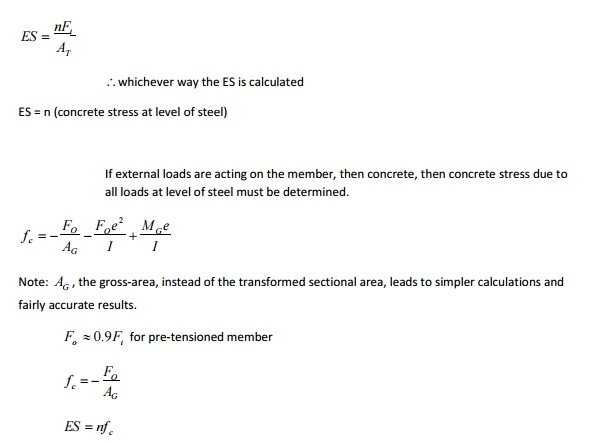
Creep (CR) Cl 18.5.2.1
Among
the many factors affecting creep are volume to surface ratio, age of concrete
at time of pre- stress, relative humidity, type of concrete (lightweight /
normal). Creep is assumed to occur in the member after permanent loads are
imposed after pre-stress. Creep occurs over a long period of time under
sustained load. Part of initial compressive strain induced in concrete
immediately after transfer is reduced by the tensile strain produced by
superimposed permanent loads.
Therefore
for bonded members, loss due to creep
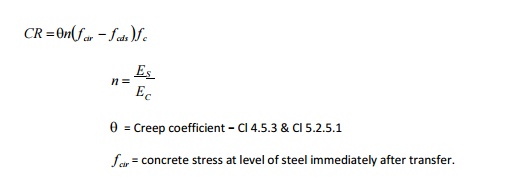
fcds
= stress in concrete at steel level due to superimposed dead loads applied to
the member after transfer of pre-stress
Shrinkage of concrete (SH) Cl
18.5.2.2
Factors
like volume to surface ratio, relative humidity, time from end of moist curing
to application of pre-stress, affect shrinkage in concrete. Shrinkage is
time-dependant and about 80% of the final loss due to shrinkage occurs in the
first year and 100% after several years.
Shrinkage
strain

Relaxation of steel (RE) Cl
18.5.2.3
When
elongation is sustained over pre-stressing cable for a long time, the
pre-stress will decrease gradually. The RE - loss due to relaxation depends on
type of steel, time, as well as the ratio of fi/fp i
where fi is the initial pre-stress and fp is the characteristic
strength of steel.
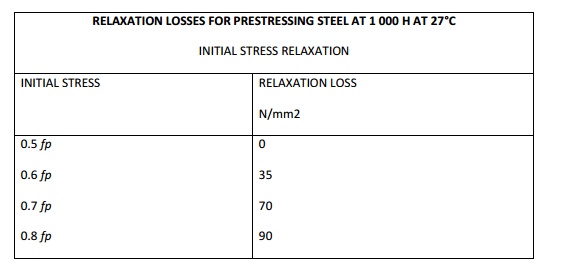
Anchorage slip (ANC) Cl 18.5.2.5
In
post-tensioning, when the jack is released, the full pre-stress is transferred
to the anchorage and they tend to deform, allowing the tendon to slacken.
Friction wedges will slip a little before they grip the wire firmly. So, in
post-tensioning the wedges are positively engaged before the jack is released.
In pre- tensioning also, the anchorage slip is compensated for during stressing
operation.
The
loss is caused by a fixed shortening of the anchorages, so the percentage loss
is higher in shorter wires than in long ones.
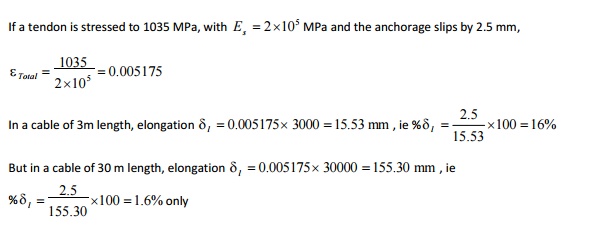
Frictional loss Cl 18.5.2.6
Frictional
loss comprise of two parts: (1) The length effect and (2) The curvature effect.
The length effect or the wobble effect of the duct is the friction that will
exist between straight tendon and the surrounding material. This loss is
dependant on the length and stress in the tendon, the coefficient of friction
between the contact materials, the workmanship and the method used in aligning
and obtaining the duct.
The
curvature effect is the loss due to intended curvature of the tendon. This
again depends on the coefficient of friction between the materials and the
pressure exerted by the tendon on the curvature.
For
un-bonded tendon, lubrication, in the form of grease and plastic tube wrapping
can be used to advantage.
For
bonded tendon lubricant in the form of water soluble oils are used during
stressing operation and flushed off with after before grouting.
Jacking
from both ends of the beam will also reduce loss due to friction.
For
straight or moderately curved structures, with curved or straight cables, the
value of pre-stressing force Px at a distance x meters from tensioning end and
acting in the direction of the tangent to the curve of the cable, shall be
calculated as below:
Px
= Poe - ( ?? + kx ).
Where
Po = pre-stressing force in the pre-stressed steel at the tensioning end acting
in the direction of the tangent to the curve of the cable, ? = cumulative angle
in radians through which the tangent to the cable profile has turned between
any two points under consideration, ? = coefficient of friction in curve;
unless otherwise proved by tests, ? may be taken as: 0.55 for steel moving on
smooth concrete, 0.30 for steel moving on steel fixed to duct, and 0.25 for
steel moving on lead, k = coefficient for wobble or wave effect varying from 15
× 10-4 to 50 × 10-4 per meter. The expansion of the equation for Px for small
values of (?? + kx) may be Px = Po (1 - ?? - kx).
Examples
To calculate ES in Pre-tensioned
beam - eccentric tendon
A
pre-tensioned beam of 100 mm x 300 mm is pre-stressed by straight wires with Fi
= 150 kN at an e = 50 mm. ES = 2.1x10 MPa, EC = 0.35x105
MPa and AP = 188 mm Estimate ES
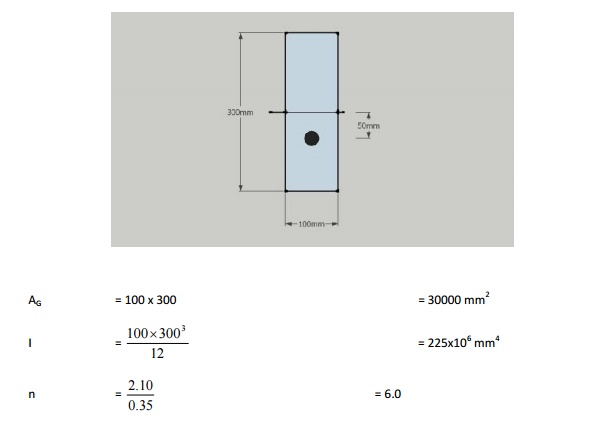

ES in Pre-tensioned beam - concentric
tendon
A
straight pre-tensioned beam 12 m long of 380 mm x 380 mm is concentrically
pre-stressed with 780 mm 2 wires anchored to bulkheads with a fi =
1035 MPa. Es = 2x105 MPa, Ec=0.33x105
Mpa

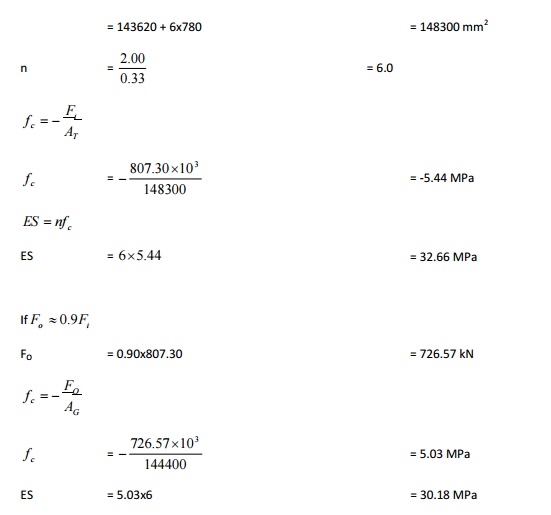
ES in Pre-tensioned beam -
Eccentric tendons at top & bot
A
pre-tensioned beam of 200 mm x 300 mm is pre-stressed with 15#5mm f wires located at 65 mm from the bottom of the beam and 3#5mm ? wires
located at 25mm from the top of the beam. f i =
840MPa.ES =2.x10MPa,EC =0.315x105
MPa Estimate ES. transfer.
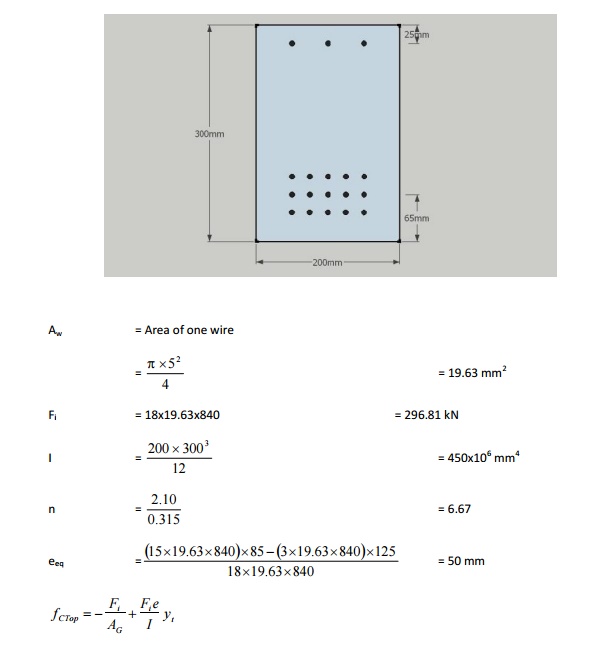
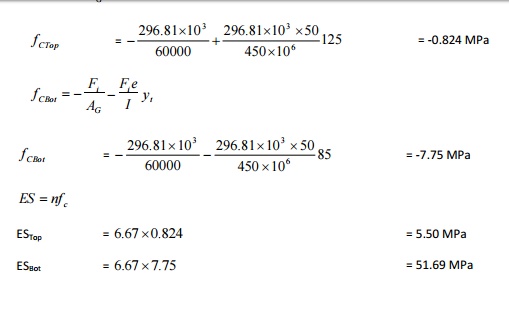
To calculate ES in Post-tensioned
beam
A
straight post-tensioned beam 12 m long of 380 mm x 380 mm is concentrically
pre-stressed with 780 mm2 wires made up of 4 tendons with 195 mm2 and the tendons are pre-stressed sequentially
with a f = 1035 MPa. ES = 2x10 MPa, EC = 0.33x105 MPa. Estimate ES
at transfer.
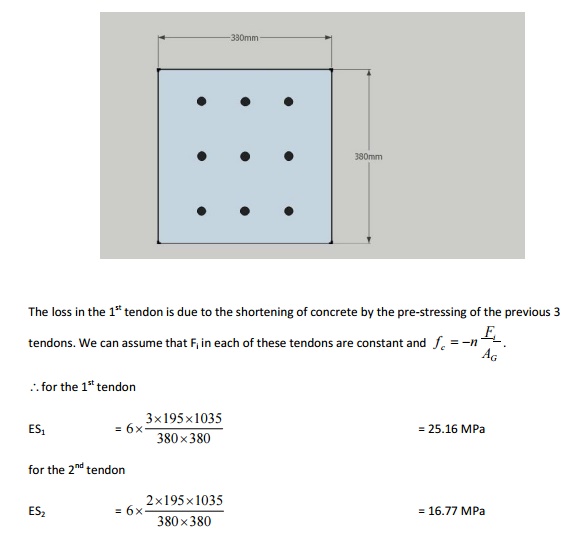
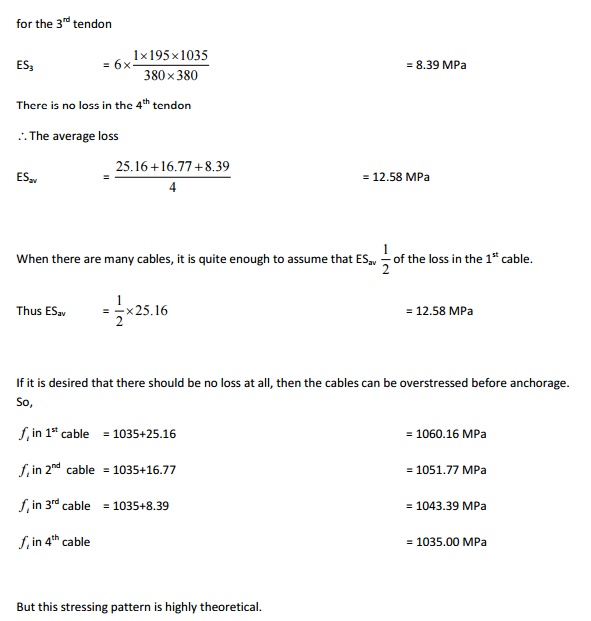
To calculate CR, SH and RE in
post-tensioned beam
A
straight post-tensioned beam of size 100 mm x 300 mm is pre-stressed with 5
wires of 7 mm f.
The 5 average pre-stress after short-term losses is f pe= 1200 MPa.
The gae at loading is 28 days. ES = 2x105 MPa, EC = 0.35x105 MPa. Estimate
CR, SH and RE assuming fp = 1715 MPa.
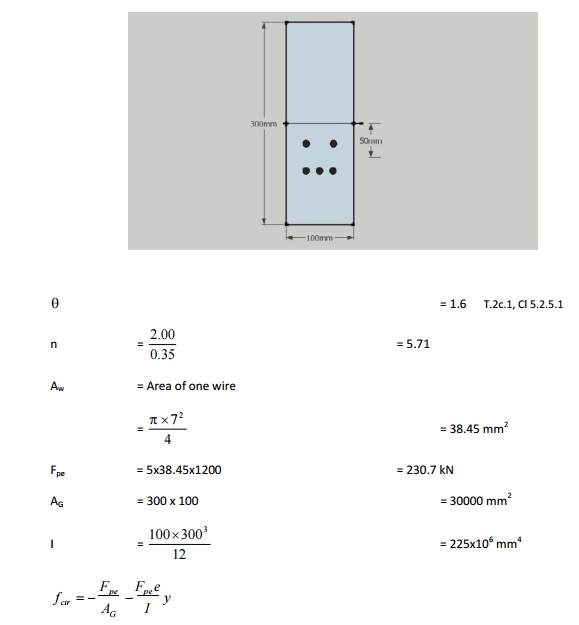
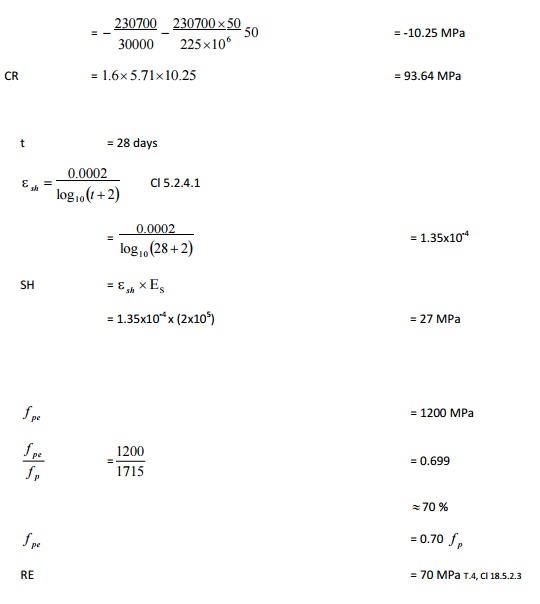
To calculate frictional losses -
tensioned from one end
A
post-tensioned beam 100 mm × 300 mm of le = 10 m is stressed by successive
tensioning and anchoring of 3 cables A, B, and C respectively as shown in
figure. Each cable has cross section area of 200 mm2 and has initial
stress of 1200 MPa. If the cables are tensioned from one end, estimate the
percentage loss in each cable due to friction at the anchored end. Assume ? =
0.35, K = 0.0015 / m.
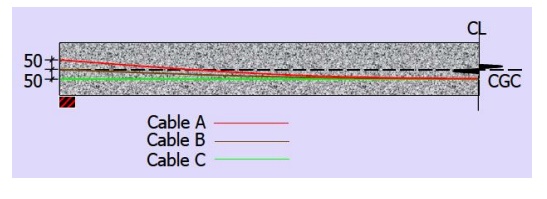
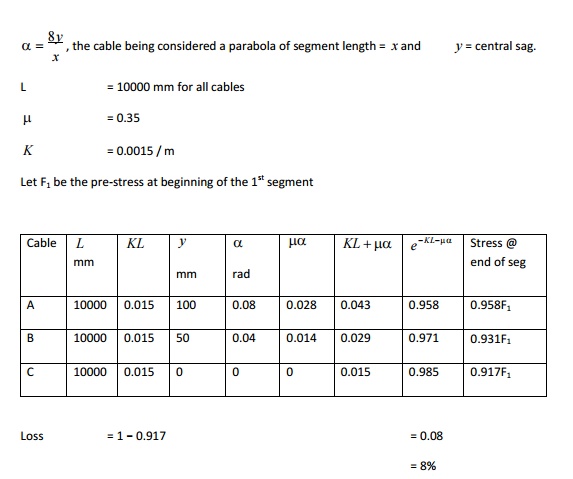
To calculate frictional losses -
tensioned from both ends
A
pre-stressed concrete beam is continuous over two spans and its curved tendon
is to be tensioned from both ends. Compute the percentage of loss of pre-stress
due to friction from one end to the center of the beam (A-E). The coefficient
of friction between the cable and the duct is 0.40 and the average wobble or
length effect is represented by k = 0.0026/m. The cable is straight between A-B
and C-D. The change in angle between BC is 0.167 radians and that between DE is
0.100 radians.
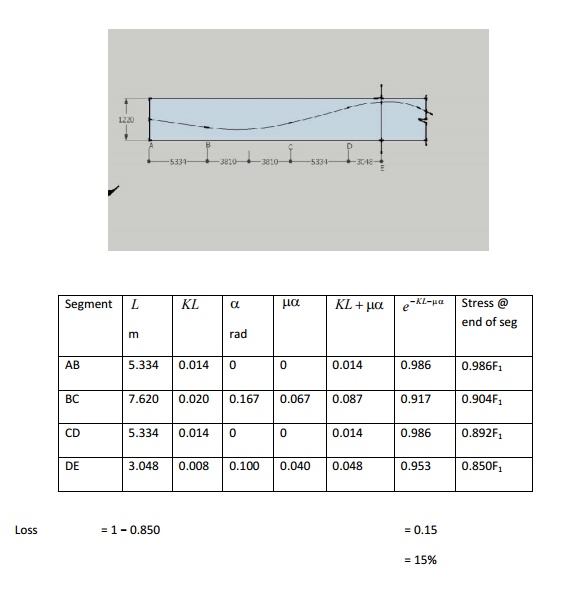
Related Topics